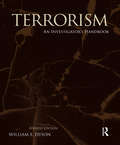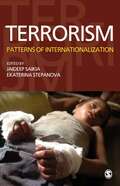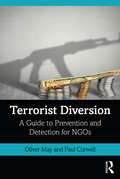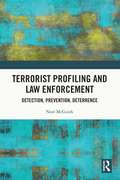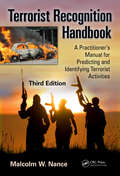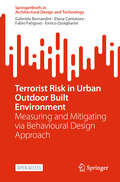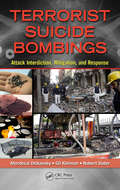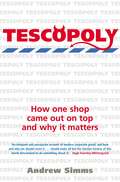- Table View
- List View
Terrorism: An Investigator's Handbook
by William E. DysonThis handbook introduces the reader to the field of terrorism investigation. Describing how terrorists operate and how they differ from other criminals, it provides an outline of how terrorism investigations should be conducted. By helping investigators to develop skills and knowledge, this guide helps them to prepare prosecutable cases against terrorists.
Terrorism: Law and Policy
by David LoweTerrorism: Law and Policy provides a comprehensive socio-legal analysis of issues related to terrorist activity. Aimed at both undergraduate and postgraduate students, the book takes a comparative approach to the law related to terrorism in a number of states, mainly those in Europe, North America, Australia and New Zealand. Beginning with an examination of the background to various currently active terrorist groups, the book focuses on those groups which are currently active and which pose a threat to security, especially at the international level. The chapters take the reader through the legal definitions of terrorism contained in various states’ statutory provisions and examine how the courts have interpreted terrorism in those states’ jurisdictions. The main aim of any terrorist investigation is prevention and so the book examines the various statutory preventative measures that states have introduced and explores the legal issues surrounding surveillance, terrorism intelligence exchange, radicalisation, use of social media, quasi-criminal provisions, asset-freezing and the nexus between terrorist activity and organised crime. Bringing together a number of themes related to terrorism and security from a uniquely legal perspective, this book builds a comparative picture of the legal counter-terrorism interventions states are adopting to increase co-operation and adopt a more united approach in the face of the international terrorism threat.
Terrorism: Patterns of Internationalization
by JAIDEEP SAIKIA EKATERINA STEPANOVATerrorism: Patterns of Internationalization provides a systematic analysis of the concepts of internationalization of terrorism. It looks into the stages and processes through which terrorism has developed in various parts of the world and binds together the facts to present a comprehensive picture of the distinguishing features that characterize the internationalization of terrorism-from local to global. Through 11 well-researched chapters, leading experts on terrorism from across five continents express their views and analyze the main patterns, stages, and levels of internationalization of different types of terrorism in a broad cross-regional perspective. The book challenges a number of conventional patterns of analysis and underlines the importance of visualizing terrorism as an act driven by political motivation, notwithstanding the fact that it is manifested through ideological or religious sentiments. It also analyzes the various tactics used by different terrorist organizations in different regions and distinguishes terrorists from other non-state actors. It dwells on the dangerous implications of the internationalization of terrorism and emphasizes the need to develop a research methodology which can help understand the current conceptualization of the phenomenon and bring forward analytical solutions. This will be an important sourcebook for the military, the police, law enforcement agencies, and government training institutes. In addition, it will also benefit political analysts and professionals such as counter-insurgency and anti-terrorism experts.
Terrorist Decision-Making: A Leader-Centric Approach (Contemporary Terrorism Studies)
by Alex Mintz Tyson Chatagnier Yair SambanThis book analyzes a series of decisions by leaders of three major terrorist organizations and identifies a unique "Decision DNA" for each of them. The authors use the Applied Decision Analysis methodology to examine organizational and operational decisions made by the leaders of three major groups: Hezbollah (Hassan Nasrallah), Hamas (Khaled Mashal), and al-Qaeda (Osama bin Laden). Decisions that were of critical importance to each organization are identified and anaylzed, to uncover the particular decision rule employed by the leader in question and to establish their "Decision DNA." A Decision DNA is unique to each leader and can be used to explain previous decisions or predict future choices. The authors demonstrate that the findings presented can be used to promote effective counterterrorism measures, and they provide a series of policy implications that arise from their examination of each leader. This book will be of much interest to students of terrorist studies, political violence, security studies, and Middle Eastern politics.
Terrorist Diversion: A Guide to Prevention and Detection for NGOs
by Oliver May Paul CurwellMany of the world’s 40,000 International NGOs (INGOs) work in places where terrorist financing, sanctions breaches, and diversion are key risks. Almost all of the top ten recipient countries of humanitarian aid alone in 2015 were high-risk jurisdictions, for example, receiving more than £7bn between them. When they feel safe to speak, sector workers share sobering stories about what might have happened to some of this money. As INGOs struggle to keep up with worsening humanitarian needs, diversion risks and their complexity remain daunting. The demands of internal stakeholders, donors, banks, and regulators are diverse and even contradictory. Public scrutiny has magnified, but is not always well-informed. Institutional donors transfer ever more risk to implementing partners, while some banks seek to avoid this business altogether, pushing some NGOs outside the global banking system. Looming over all of these converging pressures is a latticework of austere international sanctions and counter-terror regimes. It is no surprise that INGOs find themselves struggling to reconcile this complex set of expectations with their charitable missions. Yet the consequences of failing to do so can be severe; future funding is contingent on reputation, and serious offences litter the regulatory landscape. The implications of breaches can be existential for organisations and criminal for individuals. Terrorist Diversion: A Guide to Prevention and Detection for NGOs is an accessible, pragmatic guide for international NGOs of all shapes and sizes. Clearly explaining the nature of the challenge, and setting out a programme to meet it, it explores how it is possible for INGOs to manage these risks more effectively through their missions – not in spite of them.
Terrorist Profiling and Law Enforcement: Detection, Prevention, Deterrence
by Noel McGuirkThis book analyses the usefulness of terrorist profiling utilised by law enforcement officers as a pre-emptive means to assist them in the detection, prevention and deterrence of terrorism and/or its preparatory activities. It explores two main themes arising from the phenomenon of terrorist profiling: the lawfulness of terrorist profiling and the utility of profiling. These two themes are explored in three separate parts. Firstly, the book begins by drawing upon human rights concerns arising from the use of terrorist profiling by law enforcement officers. Secondly, an analytical framework capable of making determinations on the usefulness of terrorist profiling. This framework develops a profiling spectrum that ranges from formal and informal manifestations of terrorist profiling that forms the basis for evaluating its usefulness. Finally, the book presents an examination of various manifestations of terrorist profiling by separating the analysis of the ‘construction’ of profiles on the one hand, from their ‘application,’ on the other, so as to be able to identify and examine profiling’s usefulness as a technique to assist law enforcement officers make predictions about likely offender characteristics. This book ultimately concludes that terrorist profiling should only be conducted by undertaking a systematic assessment of the construction of profiles separate from the application of profiles whilst simultaneously taking into account fundamental human rights concerns with the practice of terrorist profiling. The work will be an essential resource for academics, law enforcement officers and lawyers in the disciplines of law, criminology, human rights, criminal justice and policing. As the book engages with terrorist profiling, it will also be of interest to those engaged in the psychology of terrorism.
Terrorist Recognition Handbook: A Practitioner's Manual for Predicting and Identifying Terrorist Activities, Third Edition
by Malcolm W. Nance Desmond WengerFirst published in 2003, Terrorist Recognition Handbook: A Practitioner's Manual for Predicting and Identifying Terrorist Activities remains one of the only books available to provide detailed information on terrorist methodology revealing terrorist motivation, organizational structure, planning, financing, and operational tactics to carry out atta
Terrorist Risk in Urban Outdoor Built Environment: Measuring and Mitigating via Behavioural Design Approach (SpringerBriefs in Architectural Design and Technology)
by Gabriele Bernardini Fabio Fatiguso Enrico Quagliarini Elena CantatoreThis open access book outlines the latest results in analysing, assessing, and managing terrorist risk in the urban outdoor built environment. In detail, contents refer to the outdoor Open Areas (such as streets, squares, urban parks and other public spaces in our cities) exposed to such violent events considering the physical elements and properties of the built environment and users. PThe built environment features, including layout, use and management, are combined with terrorist threats issues and user behaviours in emergency conditions, to determine a set of complementary tools for the reduction of risk and increase of urban resilience. The contents hence provide different levels of tool analysis, for risk scenario definition, risk assessment, mitigation strategies design and effectiveness evaluation, considering traditional approaches about the issue along with simulation-based approaches relying on understanding and representing user behaviors. This “behavioural design” approach offers the opportunity to manage the level of risk for specific real urban cases over going the normative limitations in Europe that are only referred to few countries and sometimes deal with the prevention of violent acts by intelligence activities as the exclusive way to face this issue. In addition, the focus on the characters of cultural and historic places and their resilience is increasing by means of introduction of mitigation and compatible solutions providing a complementary chapter for the design of resilient cities in all of their peculiarities (peripheries, consolidated, and historical). In this sense, it is one of the first organized attempts to analyse the main limitations of current solutions in these outdoor Open Areas and, at the same time, to clearly introduce the importance of human behaviours and the various choices in emergency evacuation conditions, thanks to the proposed behavioural-based simulation approach. The attention is focused on a critical aspect for historic spaces, where morphological conditions are fixed values. Thus, this book represents a sort of guidelines about these user-related issues during such violent events and is useful to both professionals and researchers in the areas of security and urban administration.
Terrorist Suicide Bombings: Attack Interdiction, Mitigation, and Response
by Robert Slater Mordecai Dzikansky Gil KleimanUrban environments are prime targets for suicide bombings over the next decade. While the threat may be ever-present, measures are available that can empower law enforcement personnel to thwart attacks, or at least mitigate the effects by reducing casualties. Written by professionals with first-hand experience, Terrorist Suicide Bombings: Attack In
Tesco Group Food
by Mary Shelman Jose B. Alvarez Damien P. McloughlinIn 2010, the world's third largest retailer created a new centralized sourcing department for fresh food and store-brand grocery products in response to changes in global supply and to better meet the needs of a new multi-channel retail environment. The case, set in late 2013, covers the development of Tesco Group Food and identifies future opportunities and challenges.
Tesco PLC: Fresh & Easy in the United States
by John A. QuelchTesco, the world's third largest retailer, is facing problems with its launch of a new retail chain in the U.S.A.
Tesco PLC: Fresh & Easy in the United States
by John A. QuelchTesco, the world's third largest retailer, is facing problems with its launch of a new retail chain in the U.S.A.
Tesco Plc.
by David E. BellTesco, a supermarket chain, has been transformed from a third-rate retailer to a global leader in the past ten years. This case describes how that was accomplished. Interviews with Tesco employees explain the company's approach to understanding customers, motivating employees, succeeding on the Internet, and creating an international strategy.
Tescopoly: How One Shop Came Out On Top And Why It Matters
by Andrew SimmsYou can shop anywhere you like -- as long as it's Tesco The inexorable rise of supermarkets is big news but have we really taken on board what this means for our daily lives, and those of our children? In this searing analysis Andrew Simms, director of the acclaimed think-and-do-tank the New Economics Foundation and the person responsible for introducing 'Clone Towns' into our vernacular, tackles a subject none of us can afford to ignore. The book shows how the supermarkets -- and Tesco in particular -- have brought: " Banality -- homogenized high streets full of clone stores " Ghost towns -- superstores have drained the life from our town centres and communities " A Supermarket State -- this new commercial nanny state that knows more about you than you think " Profits from poverty -- shelves full of global plunder, produced for a pittance " Global food domination -- as the superstores expand overseas But there's change afoot, with evidence of the tide turning and consumer campaigns gaining ground. Simms ends with suggestions for change and coporate reformation to safeguard our communities and environment -- all over the world. This book has been written and published independently from the Tescopoly Alliance and is not endorsed by them.
Tescopoly: How One Shop Came Out on Top and Why it Matters
by Andrew SimmsYou can shop anywhere you like -- as long as it's Tesco The inexorable rise of supermarkets is big news but have we really taken on board what this means for our daily lives, and those of our children? In this searing analysis Andrew Simms, director of the acclaimed think-and-do-tank the New Economics Foundation and the person responsible for introducing 'Clone Towns' into our vernacular, tackles a subject none of us can afford to ignore. The book shows how the supermarkets -- and Tesco in particular -- have brought: " Banality -- homogenized high streets full of clone stores " Ghost towns -- superstores have drained the life from our town centres and communities " A Supermarket State -- this new commercial nanny state that knows more about you than you think " Profits from poverty -- shelves full of global plunder, produced for a pittance " Global food domination -- as the superstores expand overseas But there's change afoot, with evidence of the tide turning and consumer campaigns gaining ground. Simms ends with suggestions for change and coporate reformation to safeguard our communities and environment -- all over the world. This book has been written and published independently from the Tescopoly Alliance and is not endorsed by them.
Tesla Motors
by Eric J. Van Den SteenIn mid-2013, Tesla Motors was riding a wave of success: It had launched its first really mass-produced car-the model S-to rave reviews; had recently raised first-year production targets; and had started taking orders for its next car, the Model X. Tesla seemed to be on its way to defying the skeptics and becoming the first US company to enter the car industry with a mass-produced car since WWII and the first to successfully launch a fully electric car. Or was it not?
Tesla Motors
by Eric Van Den SteenIn mid-2013, Tesla Motors was riding a wave of success: It had launched its first really mass-produced car-the model S-to rave reviews; had recently raised first-year production targets; and had started taking orders for its next car, the Model X. Tesla seemed to be on its way to defying the skeptics and becoming the first US company to enter the car industry with a mass-produced car since WWII and the first to successfully launch a fully electric car. Or was it not?
Tesla Motors (A): Financing Growth
by Stuart C. Gilson Sarah L. AbbottThe case analyzes the equity market value of Tesla Motors, the electronic car company founded and led by Elon Musk. Wall Street analysts are wildly divided on the future growth prospects for this company, and analysts' one year share price targets range from $160 to $500. The case explores in detail the valuation case made by two analysts covering Tesla, one a bull on the stock and one who is bearish. Students are asked to consider the arguments and the analytical approaches employed by each. Is Tesla a good investment or not?
Tesla Motors (B): Merging with SolarCity
by Stuart C. Gilson Sarah L. AbbottIn 2016, electric car manufacturer Tesla announced that it was making an offer to acquire solar panel manufacturer SolarCity in an all-stock offer worth $2.6 billion in Tesla stock. Tesla’s co-founder and CEO, Elon Musk, believed that the merger would generate significant cost and revenue synergies, based on his vision of the future of transportation, energy storage, and a “green” economy. However, most Wall Street analysts were highly skeptical of the deal, voicing concerns that the merger would burden Tesla with excessive debt and that Musk was using the deal to advance his personal interests (at the expense of public shareholders) and bail out Tesla. Concerns were raised over possible conflicts of interest, given that Musk owned over 20% of the stock, and sat on the board of directors of both companies. The viability of the merger was also questioned given that neither Tesla nor SolarCity had ever been profitable.
Tesla's Bid for SolarCity
by Charles C.Y. Wang Raaj ZutshiIn October 2016, Tesla asked its shareholders to ratify their $2.4 billion bid for SolarCity. Tesla had announced a series of large projects in the preceding months including the unveiling of the Model 3, the new Solar Roof, and pushing forward the opening of the Gigafactory. All of these projects required high upfront costs. Investors were left questioning the motives behind the acquisition of SolarCity, and the reality of approving the merger.
